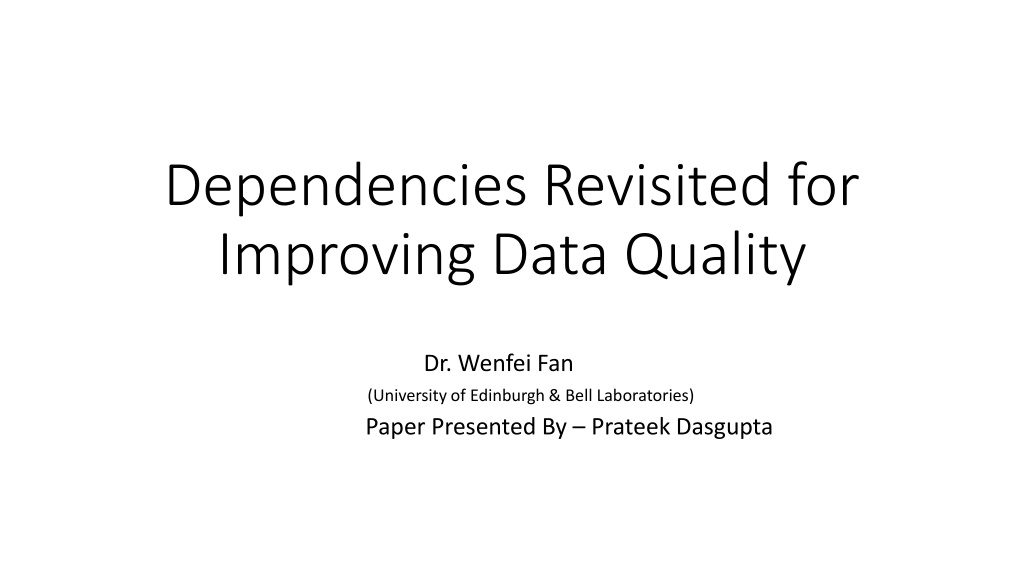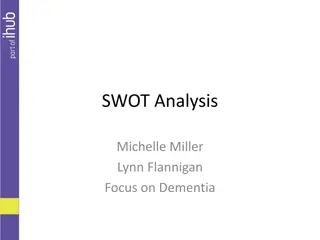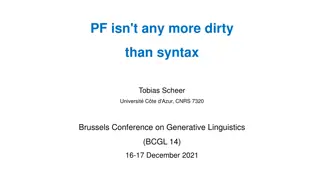The Impact of Dirty Data on Quality Improvement
Real-world data often contains errors and inconsistencies, leading to significant costs for businesses. Research activities focus on error correction, object identification, profiling, and data integration to enhance data quality. A principled approach based on data dependencies offers a promising solution by capturing semantic inconsistencies and utilizing dependencies for data cleaning.
Download Presentation

Please find below an Image/Link to download the presentation.
The content on the website is provided AS IS for your information and personal use only. It may not be sold, licensed, or shared on other websites without obtaining consent from the author.If you encounter any issues during the download, it is possible that the publisher has removed the file from their server.
You are allowed to download the files provided on this website for personal or commercial use, subject to the condition that they are used lawfully. All files are the property of their respective owners.
The content on the website is provided AS IS for your information and personal use only. It may not be sold, licensed, or shared on other websites without obtaining consent from the author.
E N D
Presentation Transcript
Dependencies Revisited for Improving Data Quality Dr. Wenfei Fan (University of Edinburgh & Bell Laboratories) Paper Presented By Prateek Dasgupta
Real-world data is often dirty US: Pentagon asked 275 dead/wounded officers to re-enlist UK: there are 81 million national insurance numbers but only 60 million people eligible Australia: 500,000 dead people retain active medicare cards In a database of 500,000 customers, 120,000 records become invalid within a year death, divorce, marriage, move Typical data error rate in industry: 1% 5%, up to 30% Errors, conflicts and inconsistencies
Dirty data is costly Poor data costs US companies $600 billion annually; Erroneously priced data in retail databases costs US customers $2.5 billion each year; World-wide losses from payment card fraud reached $4.84 billion in 2006; 30% 80% of the development time for data cleaning in a data integration project; don t forget dirty data about WMD in Iraq The market for data quality tools is growing at 17% annually 7% average of IT segments
Research activities Statistics, management, and computer science Error correction (data imputation): to localize tuples that violate a given set of semantic rules, and fix erroneous values in the tuples that are identified as violations of the rules. Object identification: to identify tuples from one or more relations that refer to the same real-world object. Profiling: to infer and discover meta-data (constraints or semantic rules) from sample data. Data integration: to resolve conflicts in the sources via object identification; quality-driven query processing by explicitly taking into account the quality of data from various sources,
A principled approach based on data dependencies A promising approach, logic-based Capturing a fundamental part of the semantics of data: inconsistencies emerge as violations of dependencies Reasoning about the semantics of the data: inference systems, analysis algorithms, Semantic profiling: discovery of dependencies for error correction and object identification Dependencies considered for data cleaning: often traditional functional dependencies, inclusion dependencies designed for improving the quality of schema
A principled approach based on data dependencies Revising traditional dependencies, for improving data quality
Outline Conditional dependencies for capturing data inconsistencies Conditional functional dependencies (CFDs) Conditional inclusion dependencies (CINDs) Other extensions Matching dependencies for object identification Static analyses: New challenges Reasoning about conditional dependencies: Satisfiability, implication, axiomatizability, dependency propagation Inferring matching rules Improving data quality with dependencies Data repairing Condensed representations of all repairs
Example: customer relation One of the central technical problems is how to tell whether the data is dirty or clean Schema: country code (CC), area code (AC), phone (phn), ... Cust(CC: int, AC: int, phn: int, name: string, street: string, city: string, zip: string) Instance: T1: T2: T3: Functional dependencies (FDs): f1: [CC,AC, phn] [street, city, zip], f2: [CC,AC] [city].
Capturing inconsistencies in the data In the UK, the zip code uniquely determines the street. cfd1: ([CC = 44, zip] [street]) This constraint specifies a semantic property of the data. It does not hold for other countries, e.g., USA It can t be expressed as standard FDs The example database does not satisfy this constraint CC AC Phn Name Street City Zip T1: T2: T3: 44 131 1234567 Mike Mayfield NYC EH4 8LE 44 131 3456789 Rick Crichton NYC EH48LE 01 908 3456789 Joe Mtn Ave NYC 07974
More example constraints In the UK, if the area code is 131, then the city must be Edinburgh (EDI) In the USA, if the area code is 908, then the city must be Murray Hill (MH) Refining the FD f1: [CC,AC, phn] [street, city, zip] by adding conditions (bindings of semantically related constants) cfd2: ([CC = 44, AC = 131, phn] [street, city = EDI , zip]) cfd3: ([CC = 01, AC = 908, phn] [street, city = MH , zip])
More examples constraints (Continued) Refining the FD f1: [CC,AC, phn] [street, city, zip] by adding conditions (bindings of semantically related constants) cfd2: ([CC = 44, AC = 131, phn] [street, city = EDI , zip]) cfd3: ([CC = 01, AC = 908, phn] [street, city = MH , zip]) CC AC Phn Name Street City Zip 44 131 1234567 Mike Mayfield NYC EH4 8LE 44 131 3456789 Rick Crichton NYC EH48LE 01 908 3456789 Joe Mtn Ave NYC 07974 None of the tuples in the example database is clean
The need for new dependencies cfd1: ([CC = 44, zip] [street]) cfd2: ([CC = 44, AC = 131, phn] [street, city = edi , zip]) cfd3: ([CC = 01, AC = 908, phn] [street, city = mh , zip]) They capture inconsistencies that traditional FDs cannot detect FDs were designed for schema design after all Data integration in real-life: source dependencies hold on a subset of sources but only hold conditionally on the integrated data They are NOT expressible as traditional FDs Do not hold the entire relation Contain constant data values, besides logical variables
Conditional Functional Dependencies (CFDs) A CFD is defined to be a pair = R(X Y ,Tp), where X Y is a standard FD, embedded in ; Tp is the pattern tableau consisting of tuples tp over X Y; In a pattern tuple tp, each tp[A] is either a constant from dom(A) or a wildcard _ (unnamed variable) that draws values from dom(A). Traditional FDs as a special case: expressing the FD f1 as Cust([CC, zip] -> [street], Tp) Pattern tableau Tp: CC Zip street 44 _ _
Conditional Functional Dependencies (CFDs) Continued A CFD is defined to be a pair = R(X Y ,Tp), where X Y is a standard FD, embedded in ; Tp is the pattern tableau consisting of tuples tp over X Y; In a pattern tuple tp, each tp[A] is either a constant from dom(A) or a wildcard _ (unnamed variable) that draws values from dom(A). Traditional FDs as a special case: expressing the FD f1 as Cust([CC, AC, phn] -> [street, city, zip], Tp) Pattern tableau Tp: CC AC Phn street city zip _ _ _ _ _ _ CFDs subsume traditional FDs.
Conditional Functional Dependencies (CFDs) Recall FDs and CFDs from previous example A single CFD representing cfd2, cfd3 and FD f1: Cust([CC,AC,phn] -> [street,city,zip],Tp) Pattern tableau Tp: CC AC Phn Street City zip 44 131 _ _ EDI _ 01 908 _ _ MH _ _ _ _ _ _ _ Each pattern tuple tp is a constraint
Semantics of CFDs Operator : a matches b (a b) Either a or b is _ both a and b are constants and a = b. tuple t1 matches tuple t2 (t1 t2): defined component-wise (a, b) (a, _) but (a, b) (a, c). A database D satisfies a CFD = R(X Y ,Tp) iff for each pair of tuples u, v D and for each pattern tuple tp Tp, if u[X] = v[X] tp[X], then u[Y ] = v[Y ] tp[Y ] Pattern tuples: tp[X]: identifying a subset {u | u D, u[X] tp[X]}; u[Y ] = v[Y] tp[Y]: enforcing the FD X Y and the pattern tp[Y] to the subset. Conditional: tp applies to the subset rather than to the entire D
Violation of CFDs Cust([CC,AC, phn] [street, city, zip], Tp) TP: Tuple t3 violates the CFD: t3[CC, AC, phn] = t3[CC, AC, phn] tp[CC, AC, phn] T3[city] tp[city] CC AC Phn Name street city zip 44 131 1234567 Mike Mayfield NYC EH48LE 44 131 3456789 Rick Crichton NYC EH48LE 01 908 3456789 Joe Mtn Ave NYC 07974 A single tuple may violate a CFD
The need of extending inclusion dependencies Example schema: Source: order(title: string, type: string, price: real) Target: book(title: string, price: real, format: string) CD(album: string, price: real, genre: string) Inclusion dependencies (INDs) from the source to the target? order(title, price) book(title, price), Order order(title, price) CD(album, price). Title Type Price Snow White CD 7.99 Book Harry Potter Book 17.99 Title Price Format CD Album Harry Potter 17.99 Hard-cover Price Genre Snow White 7.99 Paper-cover J. Denver 7.94 Country Snow White 7.99 A-book
Extending inclusion dependencies for schema matching Schema: Source: order(title: string, type: string, price: real) Target: book(title: string, price: real, format: string) CD(album: string, price: real, genre: string) There are indeed inclusion dependencies, under conditions: cind1: (order(title, price; type = book ) book(title, price)) Cind2: (order(title, price; type = CD ) CD(album, price)) These dependencies only apply to subsets of the order relation that satisfy certain patterns.
Extending inclusion dependencies for data cleaning A constraint from CD to book: it holds only if the genre of a CD is audio book and if so, then the format of the matching book must be audio cind3: (CD(album, price; genre = a-book ) book(title, price; format = audio )) The example database does not satisfy cind3 These dependencies specify patterns of semantically related data values across different relations
Conditional Inclusion Dependencies (CINDs) A CIND is a pair (R1[X] R2[Y ], Tp[Xp k Yp]), where R1[X] R2[Y ] is a standard IND from R1 to R2; Tp is a pattern tableau over Xp of R1 and Yp of R2 (distinct from X and Y ), consisting of pattern tuples of constants only Examples: cind1, cind2, cind3: cind1: (order(title, price; type = book ) book(title, price)) cind2: (order(title, price; type = CD ) CD(album, price)) cind3: (CD(album, price; genre = a-book ) book(title, price; format = audio )) CINDs: 4: (order(title, price) book(title, price), T4[type]) 5: (order(title, price) CD(album, price), T5[type]) 6: (CD(album, price)) book(title, price), T6[genre || format])
Conditional Inclusion Dependencies (CINDs) A CIND is a pair (R1[X] R2[Y ], Tp[Xp k Yp]), where R1[X] R2[Y ] is a standard IND from R1 to R2; Tp is a pattern tableau over Xp of R1 and Yp of R2 (distinct from X and Y ), consisting of pattern tuples of constants only Standard INDs are a special case of CINDs: IND: R1[X] R2[Y] CIND: (R1[X] R2[Y ],Tp[ ]) CINDs subsume traditional INDs
Semantics of CINDs D = (D1, D2), where Di is an instance of Ri , i = 1, 2. D satisfies (R1[X] R2[Y ],Tp[Xp || Yp]) iff for any tuple s in D1 and any pattern tuple tp in Tp, if s[Xp] = tp[Xp] then there exists a tuple t in D2 such that s[X] = t[Y] and t[Yp] = tp[Yp]. Pattern tuples: tp[Xp] identifies a subset {s | s D1,s[Xp] = tp[Xp]}; s[X] = t[Y ] and t[Yp] = tp[Yp]: enforcing the standard IND R1[X] R2[Y ] on the subset, and moreover, enforcing the tp[Yp] pattern to the matching R2 tuples. Each pattern tuple tp is a constraint
Other extensions(CFD & IND): Denial constraints Add Disjunction and Inequality to CFDs. Universally quantified FO sentences of the form: Ri is a relation atom for i [1, m]; is a conjunction of built-in predicates such as =, !=, , , ; May carry constants, numerical values and aggregate functions. ecfd1: CT {NYC,L1} -> AC ecfd2: CT {NYC} -> AC {212,718,646,347,917} Well studied research area for improving data quality
Other extensions of functional dependencies Studied for constraint databases and constraint logic programs Constraint Generating Dependencies: , are arbitrary constraints, which may carry constants; subsuming CFDs Constrained Tuple Generating Dependencies: subsuming both CFDs and CINDs; Higher complexity for static analyses: satisfiability, implication and finite axiomatizability
Outline Conditional dependencies for capturing data inconsistencies Conditional functional dependencies (CFDs) Conditional inclusion dependencies (CINDs) Other extensions Matching dependencies for object identification Static analyses: New challenges Reasoning about conditional dependencies: Satisfiability, implication, axiomatizability, dependency propagation Inferring matching rules Improving data quality with dependencies Data repairing Condensed representations of all repairs
Object identification Data deduplication, merge/purge, record linkage (matching): to identify tuples from one or more relations that refer to the same real-world object. Example: credit-card fraud detection Schema: credit cards and billing transactions card(C#, type, SSN, FN, LN, addr, tel, email), billing(C#, item, price, FN, SN, post, phn, email). For any instance (Dc , Db) of (card, billing), t Dc , t Db, if t[C#] = t [C#], then t[Yc ] and t [Yb] must match refer to the same holder Yc = [FN, LN, addr, tel, email], Yb = [FN, SN, post, phn, email].
Matching rules Challenges: unreliable data sources, different representations Matching rules: what attributes to compare and how to compare the attributes if t[LN, addr] and t [SN, post] match, and if t[FN] and t [FN] either match or are similar w.r.t. a similarity relation d , then t[Yc ] and t [Yb] match We can identify t[Yc ] and t [Yb] even if they radically differ in some attributes comparing t[LN, addr, FN] and t [SN, post, FN] instead of t[FN, LN, addr, tel, email] and t [FN, SN, post, phn, email]. similarity d instead of equality on FN
Matching dependencies (MDs) An MD defined on schemas (R1, R2): The MD holds on (D1, D2), where Di is an instance of Ri , 1: card[LN] billing[SN] card[addr] billing[post] card[FN] billing[FN] card[Yc ] billing[Yb] 2: card[LN] billing[SN] card[addr] billing[post] card[FN] d billing[FN] card[Yc ] billing[Yb]
Example matching dependencies If t[tel] and t [phn] equal, then t[addr] t [post] If t[email] and t [email] equal, then t[FN, LN] t [FN, SN]. 3: card[tel] = billing[phn] card[addr] billing[post] 4: card[email] = billing[email] card[FN,LN] billing[FN,SN]
Known vs. unknown relations card[LN] billing[SN] card[addr] billing[post] card[FN] d billing[FN] card[Yc ] billing[Yb] Similarity (except ), e.g., =, d : to compare data values in unreliable sources similarity metrics: edit distance, q-grams, Jaro distance, ... total mappings defined on specific domains, already given Match relation : either not given or partially defined; to be inferred via generic reasoning about matching rules; u[Z1] v[Z2] u[Z1] and v[Z2] refer to the same object; u[Z1] and v[Z2] may not be directly matched using any metric known in advance Matching dependencies: essentially used to infer the match relation (implication analysis)
Matching dependencies vs. Functional dependencies An extension of traditional functional dependencies (FDs) MDs: FDs R(X Y ): a special form of MDs when R1 and R2 are both R, X1[j] and X2[j] are the same attribute for j [1, k], Z1 and Z2 are the same attribute list, and j and are =. Differences: MDs may be defined across different relations, while FDs on a single relation MDs may be defined in terms of similarity, while FDs with equality only Implication analysis of MDs is quite different from its FD counterpart
Outline Conditional dependencies for capturing data inconsistencies Conditional functional dependencies (CFDs) Conditional inclusion dependencies (CINDs) Other extensions Matching dependencies for object identification Static analyses: New challenges Reasoning about conditional dependencies: Satisfiability, implication, axiomatizability, dependency propagation Inferring matching rules Improving data quality with dependencies Data repairing Condensed representations of all repairs
Classical decision problems The satisfiability problem is to determine, given a schema R and a set of dependencies defined on R, whether or not there exists a nonempty database instance D of R that satisfies all dependencies in . To decide whether or not dependencies are dirty themselves The implication problem is to determine, given a schema R, a set of dependencies and a single dependency defined on R, whether or not implies , denoted by |= , i.e., whether for any each instance D of R that satisfies , D also satisfies . To remove redundant dependencies
Reasoning about conditional functional dependencies For traditional FDs, the satisfiability problem is not an issue, and the implication problem is in linear time In contrast, a set of CFDs may have conflicts or inconsistencies: = R(A B, Tp), where Tp = A B _ b1 _ b2 For any nonempty database D and for any tuple t in D, says that t[B] must be both b1 and b2.
CFD,satisfiability and classical dependency Each CFD of the relation R, mapped to a value in a domain through a value function. Domain can be thought of as, there are at least two elements, there is no upper bound: possibly infinitely many Cust(CC: int, AC: int, phn: int,name: string,street: string, ) In practice, it is common to find attributes with a finite domain: Boolean, date, ... While the presence of attributes with a finite domain does not complicate the analyses of FDs, it does take a toll on CFDs
Static Analyses: CFDs vs. FDs In the absence of attributes with a finite domain: Satisfiablity Implication Finite axiomatizability CFD O(n^2) O(n^2) Yes FD O(1) O(n) Yes General setting: Satisfiablity Implication Finite axiomatizability CFD NP-complete coNP-complete Yes FD O(1) O(n) Yes
Static Analysis of CINDs The implication problem for traditional INDs is PSPACE- complete. In the absence of attributes with a finite domain, the implication problem for CINDs is PSPACE-complete. There is a sound and complete inference system for CINDs. The inference system is more involved than its traditional counterpart.
Static Analysis of CINDs In the absence of attributes with a finite domain: Satisfiablity Implication Finite axiomatizability CIND O(1) PSPACE-complete Yes IND O(1) PSPACE-complete Yes General setting: Satisfiability Implication Finite axiomatizability CIND O(1) EXPTIME- complete Yes IND O(1) PSPACE-complete Yes
CFDs and CINDs taken together We need both CFDs and CINDs for data cleaning Schema mapping For traditional FDs and INDs taken together, The satisfiability problem is in O(1) time, and The implication problem is undecidable. For CFDs and CINDs taken together, the satisfiability problem becomes undecidable, and the implication problem remains undecidable. The need for effective heuristic algorithms
Dependency propagation: The need In data exchange or data integration, dependencies that hold on sources may only hold conditionally on the target data Sources: two relations for customers in the UK and USA RS (AC: int, phn: int, name: string, street: string, city: string, zip: string) A traditional FD on RUK : zip street View definition: (RUK (CC: 44)) (RUSA (CC: 01)) The FD no longer holds on the target data The FD is indeed propagated to the target, but as a CFD
Reasoning about matching dependencies (MDs) Matching dependencies: if C holds then identify x and y. Generic reasoning: A set of MDs entails another MD , denoted by |=m , if for any instance D that satisfies , D satisfies , for all similarity and match relations satisfying their generic axioms (reflexivity, symmetric and subsuming equality for ; and additionally, transitivity and pairwise match for ) The implication problem for MDs: to determine, given any and , whether or not |=m . Logical consequence: no matter how matching rules are interpreted, if is enforced, then so must be .
The implication problem for MDs Derived MDs: card[email, addr] = billing[email, post] card[Yc ] billing[Yb] card[LN, tel] = billing[SN, phn] card[FN] d billing[FN] card[Yc ] billing[Yb] These derived MDs allow us to identify tuples based solely on the similarity metrics given on the source data. The implication analysis of MDs aims to derive matching rules on unreliable data. The implication problem for matching dependencies is in PTIME.
Outline Conditional dependencies for capturing data inconsistencies Conditional functional dependencies (CFDs) Conditional inclusion dependencies (CINDs) Other extensions Matching dependencies for object identification Static analyses: New challenges Reasoning about conditional dependencies: Satisfiability, implication, axiomatizability, dependency propagation Inferring matching rules Improving data quality with dependencies Data repairing Condensed representations of all repairs
Data Repairing Input: a relational database D and a set of dependencies Output: a candidate repair D of D w.r.t. : D |= (consistent), and D minimally differs from the original database D. Example repair models: X-repair: maximal D D, D |= (tuple deletions) S-repair: minimal (D \ D ) (D \ D) and D |= (tuple insertions and deletions) U-repair: D |= and minimal cost(D , D) (value modifications).
The repair checking problem Data repairing is an optimization problem Given , D, and D , whether D is a repair of D w.r.t. ? in PTIME for denial constraints (S-repairs) coNP-hard for universal dependencies, and in coNP for any FO sentences (S-repairs) in PTIME for FDs and acyclic INDs (X-repairs) coNP-complete for one FD and one IND together (X-repairs) NP-complete for a fixed set of either FDs or INDs (U-repairs)
Repairing algorithms Real-life data often involves error in some fields of tuples U-repair model is often used in practice Cost-based model and effective heuristic for repairing constraints by value modification Performance guarantee (precision, recall) with a high confidence ???? ?,? = ? ?,? .???? ?,? Approximation algorithm and Statistical Analysis for Improving Confidence
Repairing algorithms continued Incremental repairing: given , D, D and updates D to the database D, it is to find updates D to the repair D Master Data Management (MDM): (incremental) repairing based on available master (reference) data Dr. FN LN AC Hphn Mphn Str City Zip DOB Robert Brady 131 6884563 0791234 201 NW Row Edi EH7 4AH 07/11/65 John Smiths 020 6884563 0784567 20 Baker Str. Ldn NW1 6XE 25/12/67
Master Data Management data repairing FN LN AC phn type str city zip Item Bob Brady 020 0791234 2 201 Elm Str. Edi EH7 4AH CD Dependencies 1. [AC=020] -> [city=Ldn] 2. [AC=131] -> [city=Edi] Dependencies identify inconsistent data and work with Master Data and applying Editing rules to repair the data. Rule 1: ((zip,zip) -> (AC,str,city), tp1=()) Rule 2: ((phn,Mphn) -> (FN,LN),tp2[type] = (2))
























